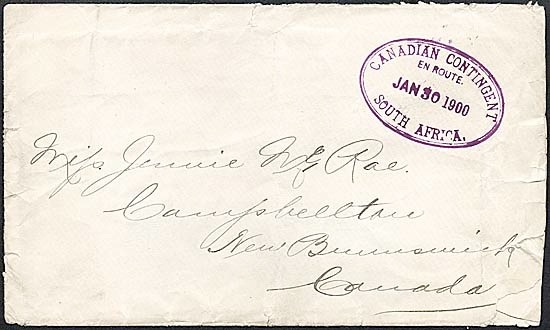This J.C. Wilson patriotic is thought to be unique, the only known Wilson patriotic showing the EN ROUTE oval handstamp indicating that Canadian Contingent mail was dispatched from a ship en route to the war. In Kenneth Rowe’s The Postal History of the Canadian Contingents, Anglo-Boer War, 1899–1902, he notes that “The ‘EN ROUTE’ handstamp is one of the scarcest Canadian Boer War markings.
In this case, the mail was sent from the first dispatch of the 2nd Canadian Contingent, consisting of a detachment of the 2nd Battalion Canadian Mounted Rifles, “C”, “D” & “E” Batteries of Royal Canadian Field Artillery, the Postal Corps and the Nursing Group. The ship S.S. Laurentian left Halifax on January 21, 1900 bearing the troops. The S.S. Laurentian stopped into port at St. Vincent in the Cape Verde Islands on January 31, where mail collected the day before and stamped with the oval handstamp was landed. The ship continued on to Cape Town, South Africa, with troops disembarking on February 17, 1900.
The cover is addressed to Mrs. Bennett, Ottawa, Ont, Canada, likely from Thomas Preston Bennett, regimental number 234, with rank of Wheeler in “D” Battery of the Royal Canadian Field Artillery, sent to his mother Jane. Thomas, who, single and living in Richmond, Ontario, was 37 years old when he enlisted in Ottawa on December 30, 1899. He was a wheelwright by trade, and he would shortly be sent overseas. The cover arrived February 15, 1900, and bears an Ottawa back stamp (see below).
In this case, the mail was sent from the first dispatch of the 2nd Canadian Contingent, consisting of a detachment of the 2nd Battalion Canadian Mounted Rifles, “C”, “D” & “E” Batteries of Royal Canadian Field Artillery, the Postal Corps and the Nursing Group. The ship S.S. Laurentian left Halifax on January 21, 1900 bearing the troops. The S.S. Laurentian stopped into port at St. Vincent in the Cape Verde Islands on January 31, where mail collected the day before and stamped with the oval handstamp was landed. The ship continued on to Cape Town, South Africa, with troops disembarking on February 17, 1900.
The cover is addressed to Mrs. Bennett, Ottawa, Ont, Canada, likely from Thomas Preston Bennett, regimental number 234, with rank of Wheeler in “D” Battery of the Royal Canadian Field Artillery, sent to his mother Jane. Thomas, who, single and living in Richmond, Ontario, was 37 years old when he enlisted in Ottawa on December 30, 1899. He was a wheelwright by trade, and he would shortly be sent overseas. The cover arrived February 15, 1900, and bears an Ottawa back stamp (see below).

During the War, “D” Battery participated in the suppression of the Boer rebellion in the western Cape Colony. A section of "D" Battery particularly distinguished itself at the battle of Leliefontein. The Brigade Division, Royal Canadian Field Artillery in South Africa used a 12-pounder breech-loading gun that began to enter Canadian service in 1897. While not as technologically advanced as the field artillery used by the British and Boer forces, which featured heavier projectiles from a recoilless gun, these guns were still used effectively by Canadian forces, and Thomas Bennett’s trade as a wheelwright may have been of use in maintaining the wood-spoked wheels of the field guns. Thomas Bennett was discharged January 10, 1901, when the duration of his 1 year enlistment had expired, with The Queen’s Medal with 3 clasps: Belfast, Cape Colony & Orange Free State.
Below left, the reverse of the cover, showing song back no. 11, with inscription type iv, making this a combination unknown to Henry Gates, and designated here as E-6. It suggests that envelopes bearing the Nelson Lodge inscription type vi, which predominates on the Maple Leaf Forever covers mailed from the war, were not distributed to soldiers until they were in South Africa, and that this J.C. Wilson envelope was carried to the war by the soldier who mailed it. It is also worth noting that this is a Type II Maple Leaf For Ever design, and that the Type II design was in circulation even before the Type I designs, which are most commonly found with the Nelson Lodge inscription, were used by soldiers in the war.
The cover was previously sold in Maresch auction 313 on October 9, 1996, and is ex. Colin Banfield.
An “exceptionally fine” plain envelope with minor edge faults, (shown below) with a superb En Route hand stamp mailed to Campbellton, N.B., with a Campbellton back stamp, sold at a Charles Leski Auction, no. 326, on May 7, 2008 for A$4,250.
Below left, the reverse of the cover, showing song back no. 11, with inscription type iv, making this a combination unknown to Henry Gates, and designated here as E-6. It suggests that envelopes bearing the Nelson Lodge inscription type vi, which predominates on the Maple Leaf Forever covers mailed from the war, were not distributed to soldiers until they were in South Africa, and that this J.C. Wilson envelope was carried to the war by the soldier who mailed it. It is also worth noting that this is a Type II Maple Leaf For Ever design, and that the Type II design was in circulation even before the Type I designs, which are most commonly found with the Nelson Lodge inscription, were used by soldiers in the war.
The cover was previously sold in Maresch auction 313 on October 9, 1996, and is ex. Colin Banfield.
An “exceptionally fine” plain envelope with minor edge faults, (shown below) with a superb En Route hand stamp mailed to Campbellton, N.B., with a Campbellton back stamp, sold at a Charles Leski Auction, no. 326, on May 7, 2008 for A$4,250.


